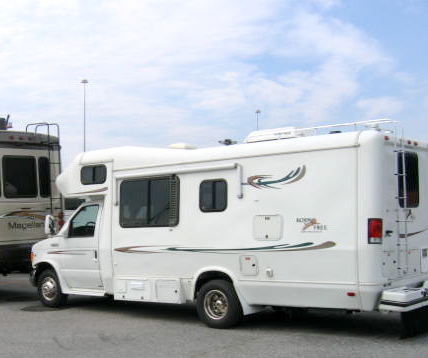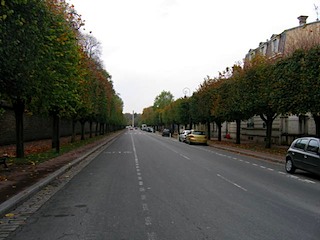 Fontainebleau makes no effort to provide parking for motorhomes or anything else. We curled through some pretty tight streets before parking half on a sidewalk and half in the street like everyone else and then walked and walked back to the very grand and elegant entrance.
Fontainebleau makes no effort to provide parking for motorhomes or anything else. We curled through some pretty tight streets before parking half on a sidewalk and half in the street like everyone else and then walked and walked back to the very grand and elegant entrance.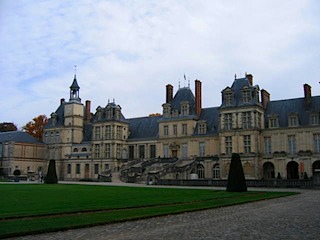 It is a wonderfully preserved place, home to Napoleon and more than a few Louis and Henris. Fortunately an audio guide was provided in English. A German couple stopped to talk to us when we got back to Rover. They had toured the US in their motorhome a few years ago. Then it was on to an overnight on a farm. We saved the address because he has a huge storage building for motorhomes and is about 40 miles south of Paris. We filled our gas tank in that town, where gas was € l.26 per liter (that’s about $ 6.50 a gallon, almost as good as Luxembourg). The financial crisis, which is about all we hear about on the BBC, is definitely helping us in the dollar-to-Euro exchange.
It is a wonderfully preserved place, home to Napoleon and more than a few Louis and Henris. Fortunately an audio guide was provided in English. A German couple stopped to talk to us when we got back to Rover. They had toured the US in their motorhome a few years ago. Then it was on to an overnight on a farm. We saved the address because he has a huge storage building for motorhomes and is about 40 miles south of Paris. We filled our gas tank in that town, where gas was € l.26 per liter (that’s about $ 6.50 a gallon, almost as good as Luxembourg). The financial crisis, which is about all we hear about on the BBC, is definitely helping us in the dollar-to-Euro exchange.
The next day we drove to Paris. We were expecting heavy traffic and that’s exactly what we got. Traffic slowed to a crawl about two miles from the ring road, but because of that we were able to read all the signs and get into the correct lanes, made it on to and off the periphery road, and drive right to the campground without any wrong turns.
The campground in Paris is right in the huge park, the Bois de Boulounge, on the west side. We felt very safe there--it was gated, fenced and busy--there were very few empty spots, even in late October.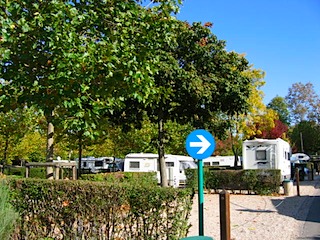 (Rover is at the far left.) The bus into the city was about a quarter mile away on a little foot path that looked like it might be a little scary and isolated after dark, but every night we got off the bus on our return with about 6 or 8 others to share the path so it was no problem.
(Rover is at the far left.) The bus into the city was about a quarter mile away on a little foot path that looked like it might be a little scary and isolated after dark, but every night we got off the bus on our return with about 6 or 8 others to share the path so it was no problem.
We spent three days and three nights in Paris, walking and walking, enjoying Monets and Renoirs and museums and markets and Starbucks. It was gray, cool and damp. There is no evidence of high gas prices affecting anyone’s choice to drive in Paris. Traffic is truly amazing. My only regret is that we couldn’t even think about getting a picture of Rover in front of the Eiffel Tower or on the Champs Elysees. There was simply no way we were going to drive there, even on a relatively calm Sunday morning when we left. And we didn't take any other pictures, either: everyone has already seen better photos of everything we saw.
We are on our way back to Amsterdam to get Rover cleaned up and ready for storage. Today was our longest day - 238 miles to just north of Antwerp, Belgium.
We are in a little campground doing laundry. We refused to pay $15 a load in Paris, so we did a little by hand and hung it on a line in Rover, where it took all three days in Paris to dry. It’s hard to plan to leave towels and bedding clean when we leave. We may spend the last night before we leave in a hotel, and we will bring suitcases full of dirty clothes home with us.
Generally we have been very impressed with the condition of the roads we have been on. We have run into few “men working” places and no actual detours. While we have tried to avoid the motorways--very expensive in France--and stay on the national- or department-level roads (think “US highway” and “state highway”), we have found that even these, as they go through the towns and villages, have purposely placed curbs, posts and speed bumps in the path of traffic. 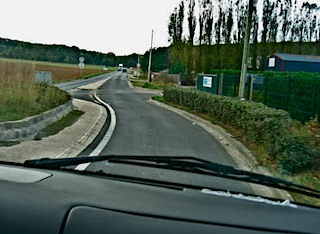 Even in obviously new street layouts, the road often narrows to one lane for 20 feet or so at the entrance to a town. Any school pedestrian crossing can have a raised speed bump crosswalk. Getting Rover through these places isn’t impossible, but we see semis with trailers going through these areas, often barely slowing down. Parking lots are another area where traffic is forced into specific paths. It is necessary for us to recconnoiter any parking lot for entrance/exit strategies before we commit ourselves.
Even in obviously new street layouts, the road often narrows to one lane for 20 feet or so at the entrance to a town. Any school pedestrian crossing can have a raised speed bump crosswalk. Getting Rover through these places isn’t impossible, but we see semis with trailers going through these areas, often barely slowing down. Parking lots are another area where traffic is forced into specific paths. It is necessary for us to recconnoiter any parking lot for entrance/exit strategies before we commit ourselves.
Road signs provide another whole level of excitement. It is necessary to know the names of other cities that may be in the direction that you want to go because you never know what will appear on the next sign. And just because a certain town is mentioned once on a sign doesn’t mean it will be mentioned again. Road numbers change frequently and are not always sign posted until you are actually on the road. Best of all, the map warned us that the French were “in the process” of renumbering roads. So I pretty much keep the map on my lap and a finger on the route. The voice of the GPS lady led us astray a couple of times and we find her really annoying, so we prefer the maps. Like I wrote once before,“roundabouts” are great way of getting back to where we really need to be...that is, if we can read the signs at them!
